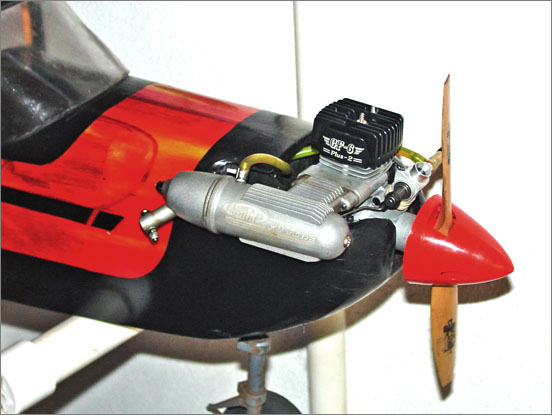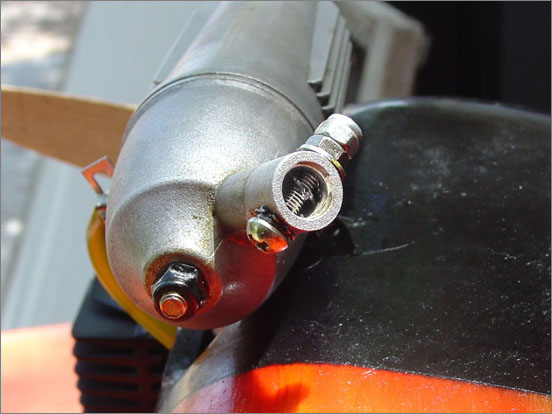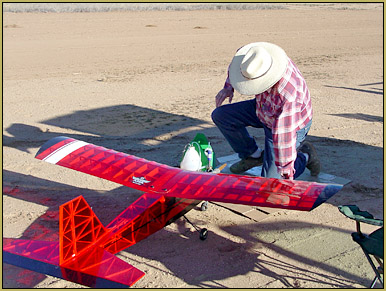I have been flying the Sig Kadet Senior, that I built from a kit, for the last ten years with a little Tower Hobbies 40 nitro motor on it. It was a splendid combination. Now, because of the price of nitro fuel these days, I am running an SF Engines GF-6 GASOLINE glow motor on it.

To fit my Kadet, I had to drill and tap new holes in the motor-mount… and then, after installation, I had to rebalance the ship because this engine is heavier than my old Tower 40. I used only a 4-ounce fuel tank with the 6cc gasoline motor and have had “over half-hour” flights while peddling around the sky at low throttle.
I followed the break-in procedure for that 6cc motor using the recommended 10-6 prop. When I tried to fly it, it ran great! I flew this model a couple of times a day, for a couple of days each week for a couple of months… and then, one day, the 6cc GF-6 quit running before I launched the aircraft. I found that tilting the ship nose-up, even just a few inches, caused the motor to quit. It leaned-out / starved-out. And tilting the model nose-down caused the motor to go really rich!
I experimented like a madman… took apart the fuel tank, actually changed tanks, blew air and fuel through the fuel and vent lines… poked a wire into the exhaust pressure fitting to be sure it was not blocked… I added small clamps to the fuel and vent lines trying to make a pressure-tight fit… I removed both needle-valves and blew air through them… I replaced the “clunk line” in the tank with Sullivan Products ProFlex Universal Fuel Line that fits very tightly to the brass tubes of the fuel tank. … I kept testing and having the same issue. The only way I could keep the motor running well enough for a flight was to tune it super rich… which barely gave me enough power for lift-off and then poor performance once airborne.
SO… desperate for a solution, I decided to create more backpressure so as to better pressurize the fuel tank.
I decided not to drill a hole into that soft muffler tail-pipe… I was wondering if it might crack the metal rather than drill it… so I used a fine cutter-bit on a moto-tool to flatten a seat for a machine screw and then punch a hole for that screw. I just used a screw that I had at hand… 3mm? … #6-32?

My first test had that screw and a nut on it blocking the tail-pipe. … The motor would barely run… too much backpressure. Next test was just the naked screw… the motor ran well when level but did quit when I tilted the model up. My next test was “the one!” when I added only a single split-washer to that screw (as shown in the photo).
Now I can set the idle to about 3000 RPM and the top-end to max-out at about 9800 on the bench (still with a 10-6 prop) and I find that I can tilt the model nose-up or -down and still have a reliable running engine. I have made a handful of successful flights with those settings.
My big Kadet Senior is a slow-flying giant that weighs-in at about 5-pounds, plus a little… this new SH Engines GF-6 hauls it around pretty well… as well as my old Tower 40. I have the model balanced a little tail-heavy, about a quarter-inch behind the main spar and it floats like a slow glider when on a high-idle… and I fly it like that, a lot! This motor is very reliable when left to run at the low-end like that. And it jumps to life when I throttle-up again.
Throughout all of my testing I was conferring with Mike Greenshields at MikeGoesFlying.com. He sells these engines and he had heard of this complaint before. We shared notes and he gave me recommendations that helped me to solve my issue with the GF-6.
In the beginning, he was not a fan of my “blocking the tailpipe” solution… saying that increased backpressure might cause the motor to overheat and quit. But then he saw my results and gave me few more tune-up ideas to try and was available to review my results. He feels that maybe the piston and sleeve became worn in my original engine set-up and so could not draw the fuel it needed. He is sending me a new piston and sleeve that I might install to see if the motor can run as it did when “new” without needing the extra backpressure. “Thanks for your help, Mike!”
We’ll see if that piston/sleeve makes a difference… I will keep you posted!
— Eric

